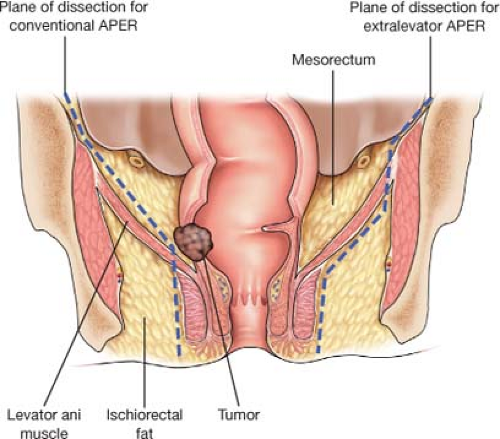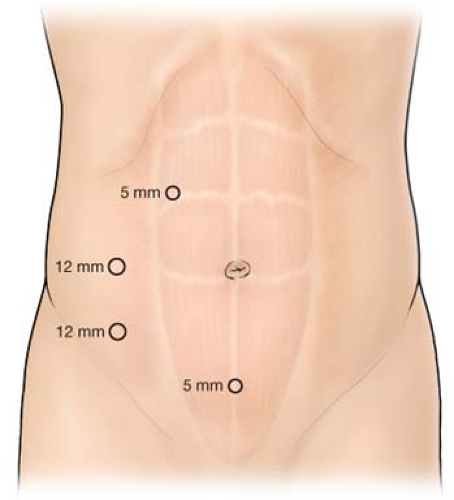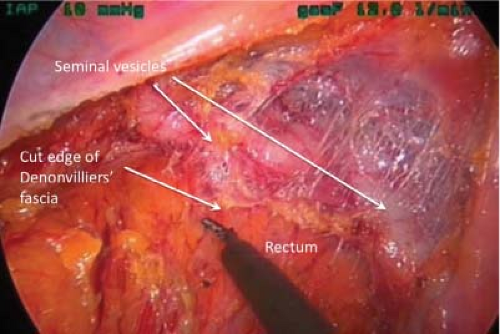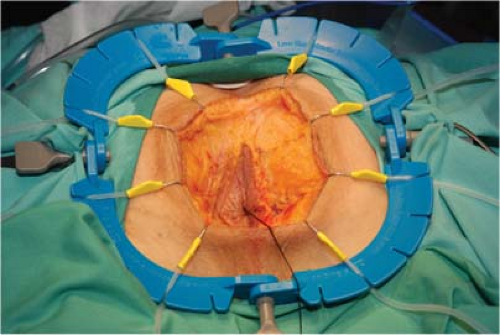Abdomino-Perineal and Total Colon Resections
Robert J.C. Steele
Kenneth L. Campbell
Introduction
The term abdomino-perineal resection (APR) is usually used to describe proctectomy for low rectal cancer or anal cancer which has not responded to radiochemotherapy. In recent years, it has become evident that the outcome after APR for rectal cancer is worse, especially in terms of local recurrence, than after anterior resection. Thus, the vast majority of patients with low rectal cancer requiring APR will have had preoperative radiotherapy usually combined with chemotherapy, which has important implications for perineal wound healing. Recent work from England and Sweden has demonstrated that the poor results after APR are primarily related to inadequate circumferential clearance of the tumor with consequent circumferential margin (CRM) involvement by tumor. In addition, historically, intraoperative perforation of the rectum is relatively common during APR, which is also associated with an increased risk of local recurrence.
So why should CRM involvement and intraoperative perforation be more common with APR than with anterior resection? With the widespread adoption of total mesorectal excision, there has been a focus on carefully following the mesorectum down to the pelvic floor in order to achieve maximum tumor clearance and a very low anastomosis. As the mesorectum thins out in the distal part of the rectum just above the anal canal, there is an area of rectal wall that is denuded of fibro fatty tissue. The only patients requiring APR are those with tumors that involve this part of the rectum, which is exposed during total mesorectal excision. Thus, the surgeon who is accustomed to carrying out total mesorectal excision will tend to “cone down” on to the tumor when carrying out abdominal dissection for an APR, thus increasing the risk of circumferential margin involvement (Fig. 1). Traditionally, the perineal part of the operation is done with the patient in the Lloyd-Davies position, which affords a relatively poor view of the perineal anatomy. In order
to avoid damage to the surrounding structures, particularly the male urethra, the surgeon may be tempted to stay close to the rectal wall and risk perforation. The extralevator technique of APR described in this chapter is intended to avoid these problems.
to avoid damage to the surrounding structures, particularly the male urethra, the surgeon may be tempted to stay close to the rectal wall and risk perforation. The extralevator technique of APR described in this chapter is intended to avoid these problems.
It must be emphasized that only patients with very low rectal tumors should be treated by APR. Occasionally, because of poor sphincter function, a decision may be taken not to perform an anastomosis for a tumor that would be anatomically suitable for total mesorectal excision and a coloanal anastomosis. In this case, it is preferable to preserve the pelvic floor and carry out an ultralow Hartmann’s procedure rather than exposing the patient to the morbidity of a perineal wound.
Although the term APR is usually used to describe cancer treatment, there are, of course, other indications for proctectomy, notably inflammatory bowel disease and familial adenomatous polyposis, and while the majority of patients requiring proctectomy for ulcerative colitis will undergo restorative proctocolectomy with ileoanal pouch formation, some will be best served by proctectomy because of poor sphincter function and most surgeons are reluctant to carry out reconstruction for Crohn’s disease. Proctectomy for inflammatory bowel disease does not require radical excision of the pelvic floor and most patients will be suitable for intersphincteric dissection. This is also described here.
Patient Preparation
Before APR, we do not subject the patient to full bowel preparation; rather we ask them to adhere to a fluid diet for 2 days preoperatively and a phosphate enema is administered on the day before surgery to clear the rectum of feces. Another important part of preoperative preparation is stoma siting by a trained stoma therapist who will carefully counsel the patient and identify the optimal position for a stoma bag, which is carefully marked immediately preoperatively.
Open Abdominal Procedure for Cancer
Position
The patient is positioned with legs apart on a flat table. Here, we do not employ Lloyd-Davies stirrups. A Foley catheter is inserted per urethram at the beginning of the operation. If, in a male, there is any difficulty in passing the catheter, then a suprapubic catheter is inserted intraoperatively.
Access
We prefer an infraumbilical midline incision, which can be extended a few centimeters above the umbilicus if necessary, although it is possible to use a low transverse incision with the proviso that siting the colostomy may be more difficult with this approach. The skin is opened with cutting diathermy and the rest of the incision is completed with fulguration. Once the abdomen is opened, it is our preference to use an Omnitract® retractor. After a laparotomy with particular attention to the liver and the possibility of peritoneal seedlings, the small bowel is packed into the right upper quadrant using a large gauze pack and an appropriately sized retractor blade. The left side of the abdomen is retracted using two Mayo retractors and a long, right-angled retractor is used to retract the lower aspect of the right side of the abdomen to afford good access to the pelvis. In a woman with an intact uterus, two sutures are placed through the broad ligament on either side of the body of the uterus and passed through the skin on either side of the lower end of the midline incision. These are then tied in order to hitch the uterus up and to open out the rectouterine pouch. The operating surgeon stands on the left-hand side of the patient and the first assistant retracts the sigmoid colon to the patient’s right.
Mobilization of the Left Colon
Using diathermy on the fulgurate setting and traction with either a DeBakey’s forceps or a handheld swab, an incision is made in the peritoneum immediately posterior to the “white line” that indicates the fusion of the visceral with the parietal peritoneum. By developing the embryonic plane identified by this maneuver, the sigmoid colon is fully mobilized to the midline taking care to identify the gonadal vessels, the ureter, and the inferior hypogastric nerves. The dissection is extended superiorly to mobilize the descending colon, although it is not usually necessary to mobilize the splenic flexure unless there will be difficulty in carrying out a colostomy without tension. The dissection is continued in the plane immediately anterior to the inferior hypogastric nerves down to the sacral promontory until the plane between the back of the sacrum and the mesorectum is identified. The peritoneum on the right side of the sigmoid colon is then opened and if the dissection has been taken to the midline, this will run directly into the space immediately anterior to the inferior hypogastric nerves that has already been defined.
The peritoneum is then dissected up to the inferior mesenteric artery, which is ligated and divided close to its origin. Then, according to the vasculature, the sigmoid mesocolon is divided up to approximately the midpoint of the sigmoid colon incorporating the inferior mesenteric
artery in the resection specimen. The sigmoid colon is then divided using a single firing of a linear anastomosing stapler so that both ends are stapled closed minimizing the risk of contamination. The proximal colon is then packed into the left upper quadrant of the abdomen with a gauze pack and an appropriate right-angled retractor.
artery in the resection specimen. The sigmoid colon is then divided using a single firing of a linear anastomosing stapler so that both ends are stapled closed minimizing the risk of contamination. The proximal colon is then packed into the left upper quadrant of the abdomen with a gauze pack and an appropriate right-angled retractor.
Mobilization of the Rectum
Attention is then turned to the pelvis. The rectum is retracted forward firmly and the plane between the mesorectum and the sacrum is developed using diathermy dissection, taking care not to breach the mesorectum or to damage the presacral vessels. By retracting the rectum to the right and left to facilitate dissection, the inferior hypogastric nerves are traced down into the pelvis until the inferior hypogastric plexus has been identified on both sides. The nerve supply to the rectum coming from the inferior hypogastric plexus is divided on either side and a Ligaclip® is placed on the pelvic side of the divided nerve. In the male, the peritoneum is divided just anterior to the apex of the rectovesical pouch. A plane is then developed between the seminal vesicles and the anterior mesorectum and continued to the base of the seminal vesicles. In the female, a plane is developed between the vagina and the mesorectum. The dissection only has to extend 1 or 2 cm distally and must stop well above any anteriorly situated tumor. Where the anterior wall of the vagina is to be removed (and we do this for all anteriorly situated tumors), a transverse incision through the posterior vaginal wall can be made at this stage. Posteriorly, the dissection continues in the midline but stops before the proximal end of the coccyx. It cannot be emphasized enough that the dissection of the rectum should stop at this point; further distal dissection will separate the rectum from the pelvic floor at the point where the mesorectum becomes attenuated and this runs the risk of exposing a low rectal cancer.
On completion of this part of the operation, a swab is then placed posterior to the rectum as distally as possible. The divided end of the proximal colon is then brought out through a trephine incision at the premarked site on the left side of the abdomen. We prefer, where possible, to bring the colon out through the rectus muscle splitting the fibers vertically rather than dividing them horizontally. The midline wound is then closed using No. 1 PDS for the deep fascia and staples for skin. Drains are not inserted at this stage.
Open Rectal Mobilization for Inflammatory Bowel Disease
The mobilization of the rectum proceeds in the plane immediately outside the mesorectum as described above. We do not advocate close rectal dissection for inflammatory bowel disease as this can be associated with considerable bleeding and risk of rectal wall perforation. In addition, careful adherence to the mesorectal plane avoids damage to the pelvic nerves and presacral vessels. Anteriorly, the dissection is carried on distally to the inferior border of the seminal vesicles in the male and as far distally as possible in the rectovaginal plane. For this part of the operation, the use of a lipped St. Mark’s retractor preferably with integral fiber-optic illumination provides excellent exposure and vision. After division of the nerve supply to the rectum from the inferior hypogastric plexus, the plane immediately outside the mesorectum is then pursued laterally and posteriorly by means of traction with the surgeon’s hand on the rectum, countertraction with the St. Mark’s retractor on the lateral pelvic walls and careful diathermy dissection. The diathermy spatula on the end of the long diathermy blade can be angled in order to facilitate this dissection, which can be particularly challenging in the male pelvis. The specifically designed Heald retractor (similar to the St. Mark’s retractor but with a reversed curve) can be very helpful in retracting the rectum forward in order to expose the mesorectal plane distally. By persisting with this circumferential dissection, the clean muscle tube of the rectum just above the levator muscles is finally exposed. At this point, a swab is placed down as far as possible in the pelvis behind the rectum and the abdomen is closed.
Laparoscopic Abdominal Procedure for Cancer
Preoperative preparation and positioning is as described for the open procedure, as the laparoscopic approach is impeded by angulation at the hips. In an obese patient, a wedge placed under the left-hand side can help with access to the inferior mesenteric artery.
Access
A pneumoperitoneum is induced via an open cut down at the marked colostomy site, and the main (12 mm) camera port is placed on the patient’s right side at the level of the umbilicus and just lateral to the midclavicular line. A 12-mm port is then placed 5 cm below and medial to the anterior superior iliac spine and serves as the main right-hand operating port. Finally, 5-mm ports are placed just above and to the right of the umbilicus and in the midline suprapubically (Fig. 2). Unless warmed, the CO2 flow should remain remote from the camera port to prevent fogging and the camera should be thoroughly warmed prior to the procedure. With a filter on the open tap of one of the ports, the CO2 flow is set at 10 L/min to facilitate evacuation of diathermy smoke.
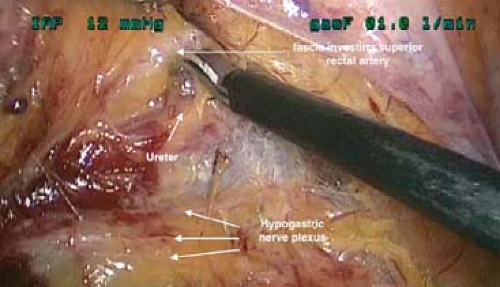 Fig. 3. Medial to lateral dissection of the sigmoid mesocolon, with special attention to identification of the hypogastric nerves and the left ureter. |
The patient is now gradually placed head-down position in collaboration with the anesthetic staff to allow physiological re-equilibration. If the stomach is distended, a temporary nasogastric or orogastric tube can be inserted. The omentum is then placed over the liver and the small bowel manipulated out of the pelvis using atraumatic bowel graspers, so that, with the aid of the head-down positioning and some right side down tilt, the small-bowel loops can be stacked in the right upper abdomen. With the operator and camera holder on the patient’s right side, an assistant stands between the patient’s legs and using an atraumatic grasper through the suprapubic port, elevates the sigmoid mesocolon.
Dissection of the Vascular Pedicle
We use monopolar diathermy with either scissors or a hook as opposed to ultrasonic or other energy sources. This may be more demanding in terms of obtaining meticulous hemostasis, but we have found it superior in terms of finding and staying within avascular tissue planes.
Dissection begins with a long incision using scissors through the peritoneum on the medial aspect of the base of the sigmoid mesocolon. Gas is released into the loose areolar tissue between the mesorectum and sacral promontory and extends along the fascia surrounding the superior rectal artery. Our target is to find that fascia as it is continuous up to the origin of the inferior mesenteric artery and along the back of the mesorectum down into the pelvis. Dissection in this space will preserve the hypogastric plexus below and guide dissection from medial to lateral behind the mesocolon and above the ureter and gonadal vessels (Fig. 3). We then switch to the hook to dissect the origin of the artery taking care to avoid damage to the hypogastric nerves. Several options exist for controlling the vascular pedicle, but we routinely use the bipolar vessel sealing device LigaSure®, which we have found to be reliable and convenient. Following division of the inferior mesenteric artery, the mesocolon is dissected from the retroperitoneal structures from medial to lateral upward to Gerota’s fascia and the pancreas and downward over psoas and toward the mesorectal plane. Finally, the lateral peritoneal attachment is divided with scissors.
Rectal Dissection (Male Patient)
Great care is required at the start of the posterior mesorectal dissection to avoid damage to the hypogastric nerves. In order to achieve the traction and countertraction necessary to reveal the loose areolar tissue plane, dissection takes place laterally and anteriorly at an early stage with the lower posterior dissection as a later phase. The bowel grasper through the suprapubic port is used to retract the rectum upward from the pelvis and move it from side to side, and the camera holder can use an extra grasper or pledget in a 5-mm port placed through the stoma site to deliver countertraction to the lateral pelvic walls or the seminal vesicles.
We find the hook the most effective and precise instrument for the majority of the rectal dissection, and we use an instrument with a hollow channel, which allows continuous evacuation of smoke. We believe that a 30-degree telescope is critical in maintaining clear views of this dissection. The anterior dissection stops at the level of the prostate below the seminal vesicles (Fig. 4). As the lateral dissection proceeds, the hypogastric nerves are seen converging toward the rectum at the commencement of the so-called lateral ligaments. Ligaclips® are placed medial to the nerve prior to division of this tissue, which should be the only point in this dissection at which some bleeding may be noted. The posterior plane of dissection is now beautifully exposed, but it is important not to continue as this plane will rapidly cone in toward the anus preventing a good quality cylindrical resection. Accordingly, a swab is simply placed down posteriorly at this point for retrieval during the perineal phase.
Rectal Dissection (Female Patient)
In the case of a female patient, our set up would vary slightly in that the uterus may require to be hitched up to the abdominal wall with a Proline® suture either directly through the body or by lateral suture through the broad ligaments, whichever displays the anatomy best. In addition, as dissection progresses in the rectum, we would place a Kelly retractor in the vagina to stretch it upward and pull it away from the rectum facilitating traction and countertraction for the anterior portion of dissection in the female.
Formation of Colostomy
An appropriate site in the colon is selected and the mesocolon divided to this point
using the LigaSure® device. The colon is then divided using an endoscopic linear cutting stapler, and the proximal colon is exteriorized at the marked site with orientation being carefully checked before desufflation and withdrawal of the laparoscopic instruments. Facial repairs are undertaken at the larger port sites prior to skin closure.
using the LigaSure® device. The colon is then divided using an endoscopic linear cutting stapler, and the proximal colon is exteriorized at the marked site with orientation being carefully checked before desufflation and withdrawal of the laparoscopic instruments. Facial repairs are undertaken at the larger port sites prior to skin closure.
Laparoscopic Rectal Mobilization for Inflammatory Bowel Disease
We perform this dissection in the mesorectal plane in identical fashion to that described for cancer. Inflammatory change and fibrosis within the planes will pose the same problems as in open surgery, and more use of sharp scissor dissection and the use of pledgets may be required. Preservation of the nerves rather than preservation of the mesorectum is, of course, the priority with inflammatory bowel disease, so, on occasions, some dissection into the mesorectum may be necessary where there is inflammatory reaction and doubt about the position of the pelvic nerves. Otherwise dissection mostly proceeds as described for APR. Following division of the lateral ligaments, dissection is completed behind the prostate, and we find that pledgets are the most useful retractors at this point. Posterior dissection should now proceed easily down to the pelvic floor and with the bulk of the mesorectum dislocated and retracted upward, good views and good access to the anus are obtained.
The Extralevator Perineal Procedure for Cancer (Note: This Is Identical for Both Open and Laparoscopic Approaches)
Position
After completion of the abdominal part of the procedure, the wound is dressed and a colostomy bag is applied to the stoma. The patient is then turned prone and it is important to have the patient’s pelvis elevated either on pillows or a foam wedge in order to obtain good access to the perineum (Fig. 5). We also find it useful to have the legs split as this improves access. The anal canal is closed using a No.1 silk suture.
Incision
An elliptical incision is made just outside the perianal skin and extended over the coccyx. The incision is then deepened to the coccyx and around the anal canal immediately outside the external sphincter complex. We then find it helpful to use a Lone Star® retractor with eight large hooks to hold the incision open. These hooks are repositioned to the deeper tissues as the dissection proceeds (Fig. 6).
Rectal Excision
The plane immediately outside the external sphincters is then developed until the levator ani muscles are exposed on both sides. Littlewoods forceps are then applied to the skin around the anal canal and traction is exerted in a caudal direction to facilitate deepening the incision anteriorly through the transverse perineal muscles. Attention is then turned to the coccyx, which is excised and the underlying Waldeyer’s fascia divided to gain access to the pelvis. The swab in the pelvis is then retrieved and the levator muscles on either side are divided as far laterally as possible (Fig. 7). The rectum and attached sigmoid colon is then withdrawn through the pelvic defect exposing the plane between the rectum and the prostate or vagina (Fig. 8). This plane is then carefully developed and in the male, using the Ligaclip®, which has been placed on the inferior hypogastric plexus as a starting point, it is possible to trace the parasympathetic nerves as they cross the surface of the prostate. If the plane of dissection is too close to the prostate, this will damage the nerves and will also cause troublesome venous bleeding from the prostate, which requires suture ligation. In the female, for a posterior
tumor, the plane of dissection in the rectum and vagina is continued distally. The puborectalis muscle is then divided on either side and the central perineal tendon is divided in order to detach the specimen. If there is an anterior tumor in the female, the plane between the rectum and the vagina is not developed but rather the posterior wall of the vagina is removed with the specimen. In the male, when the base of the prostate has been reached, the puborectalis muscles are divided on either side and, taking great care to avoid injury to the urethra, the central perineal tendon is divided and the specimen detached. Hemostasis is then achieved and in the female, where the posterior wall of the vagina has been excised, this involves careful over-sewing of the cut edge of the vaginal wall. As the rectum has not been dissected down to the pelvic floor, this procedure will produce a cylindrical specimen where the mesorectum superiorly is attached to the connective tissue on the surface of the levator muscles (Fig. 9). Thus, the risk of circumferential tumor margin involvement for a low rectal cancer is minimized.
tumor, the plane of dissection in the rectum and vagina is continued distally. The puborectalis muscle is then divided on either side and the central perineal tendon is divided in order to detach the specimen. If there is an anterior tumor in the female, the plane between the rectum and the vagina is not developed but rather the posterior wall of the vagina is removed with the specimen. In the male, when the base of the prostate has been reached, the puborectalis muscles are divided on either side and, taking great care to avoid injury to the urethra, the central perineal tendon is divided and the specimen detached. Hemostasis is then achieved and in the female, where the posterior wall of the vagina has been excised, this involves careful over-sewing of the cut edge of the vaginal wall. As the rectum has not been dissected down to the pelvic floor, this procedure will produce a cylindrical specimen where the mesorectum superiorly is attached to the connective tissue on the surface of the levator muscles (Fig. 9). Thus, the risk of circumferential tumor margin involvement for a low rectal cancer is minimized.
Stay updated, free articles. Join our Telegram channel

Full access? Get Clinical Tree


